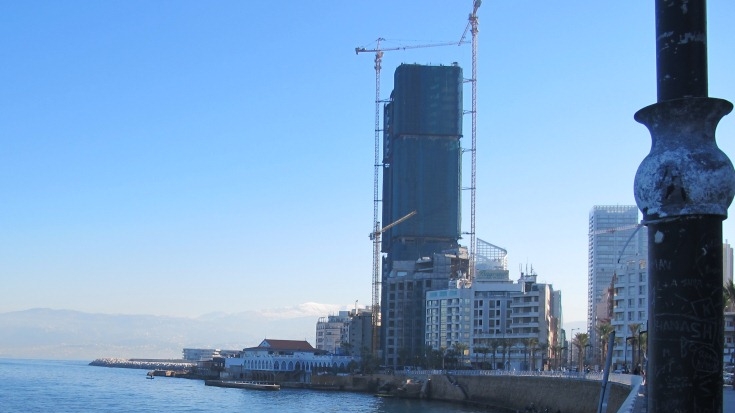Water in Lebanon: Matching Myth with Reality

Throughout history, countless songs and poems have celebrated Lebanon’s sweeping and picturesque landscape: snow-capped mountains overlooking a pristine Mediterranean, wandering rivers dividing bustling cities and towns, and mounds of colorful fruits and vegetables on fertile spring-fed lands.
Today, however, it can be hard to match the reality with the poems. Especially when it comes to water, there is little to sing about. A large majority of those living in Lebanon only have access to water for a few hours per day. The little water they do receive from public infrastructure is generally perceived to be of poor quality. Those who can afford it, resort to expensive bottled and tanker water. Over 20,000 illegal groundwater wells have also been dug across the Greater Beirut and Mount Lebanon area alone. It is where over half of the Lebanese population lives, works, and endures the dramatic winter floods, polluted sea waters, and either poor quality or highly expensive water.
For decades, the Lebanese have grappled with how to improve the way in which natural water resources are managed. Debates abound on the role of the private sector in water and sanitation, number of dams needed, relevance of agriculture and food security, cost effectiveness of infrastructure, public acceptance of water meters, and perhaps most critically, what to do first.
History has also proven that these debates can be particularly productive, especially when informed by different opinions and voices. The impressive Qaroun Dam and associated hydroelectric infrastructure, the many water laws dealing with complex issues of inter-basin transfers, private sector participation and corporatization of public water companies, and more recently the development of the National Water Sector Strategy, developed over several years and approved by Parliament in March 2012, are a few examples of successful Lebanese projects that benefited from intense national debate.
Furthermore, the importance of ensuring the safety of water supplied across Lebanon is something that everyone can agree on. The World Bank Group has put the safety of water service delivery at the heart of all the water projects it finances in Lebanon.
Drinking water from the tap: Delivering international water quality standards in partnership with the private sector
In 2010, following a series of particularly arid summers, rising popular discontent about the quantity and quality of water, and the clear need for an urgent solution to close the widening water gap in the short term, the World Bank agreed to partially finance the Greater Beirut Water Supply Project. A number of institutions have joined forces for implementation, including the Ministry of Energy and Water (MOEW), Council for Development and Reconstruction (CDR), and the Beirut Mount Lebanon Water Establishment (BMLWE).
This critical project will provide an additional 250,000 cubic meters of water every day to the Greater Beirut and Mount Lebanon region. It will use a combination of underground tunnels, pipelines, storage reservoirs, and a large water treatment plant, the first of its kind in Lebanon. The Ouardaniyeh water treatment plant will be located south of Beirut and will deliver drinking water to international quality standards through an innovative Design-Build-Operate (DBO) contract between the BMLWE and the private sector.
Recognizing BMLWE’s pioneering commitment to implementing innovative solutions to longstanding water problems, the World Bank Group recently partnered with the Islamic Development Bank to provide additional support. A US$680,000 grant to the Greater Beirut project will assist BMLWE in attracting and benefiting from the private sector. The grant will finance the hiring of a private, water design firm to review the proposed design of the water treatment plant, along with the various treatment technologies submitted for consideration, and assist with the supervision of construction.
Dam Safety: Bringing International Expertise Onsite
Looking ahead, the long term sustainability of the Lebanese water sector will rely on measures that simultaneously increase the volume of water available and decrease the amounts wasted or lost.
To increase the volume of water stored and made available for use, a number of the dams identified in the National Water Sector Strategy are at various stages of review, design and construction. Largest amongst these is the Bisri dam which will store an additional 120 million cubic meters of water for potable use.
In light of the size and complexity of the proposed Bisri dam, the Lebanese Government has recruited a panel of experts on dam safety to review the design of the dam and to ensure that all safety aspects of design, construction, operation, and maintenance are incorporated into the final plans. The panel includes internationally-renowned experts in dam design, hydrogeology, hydrology, and seismology, with direct experience on many of the world’s largest and most complex dams.
The Lebanese government has clearly demonstrated a commitment to the safety and sustainability of water sector projects. The actions of the government have confirmed both to the World Bank Group and other development partners that international best practice will be incorporated into all projects. Perhaps more importantly, these actions also confirm to water users across Lebanon, that their need for clean, continuous, and safe water has been not only debated, but heard.




